Energy-efficiency approach for long range wireless communication
According to recent research, the wireless sensor networks which consume low levels of energy become more and more popular nowadays, so the research trend of optimizing energy for wireless
sensor networks is rapidly increasing. LoRaTM technology is a modulation technique that provides
long-range transfer of information and low power consumes. Besides, LoRaWANTM is a network
protocol that is optimized for battery-powered end devices. The LoRaTM and LoRaWANTM can be
considered a suitable candidate for wireless sensor networks, which can reduce power consumption and extend the communication range. In the post personal computer era, when most devices
are battery-based, the more energy consumption saved the better and more attractive users. In
this paper, we study adaptive mechanisms in the transmission parameters of the LoRaTM network
and proposed an energy-efficiency solution for the adaptive algorithm. The proposed algorithm
helps reduce the energy consumption of LoRA-based internet of thing system while keeping all
quality parameters unchanged. This research not only introduced the reference hardware of a sensor node in wireless sensor networks but also conducted experiments on typical LoRaTM network
infrastructure. We conduct three different experiments to validate our proposed algorithm with
real systems which use air quality sensors and an ultra-low-power micro-controller unit board from
Texas instruments. Our experimental results with both real systems and simulations show that we
achieve at least 4% energy consumption when the proposed algorithm used. Although energy
consumption is saved, the quality of services including communication range and packet arrival
rate are kept unchanged. The proposed algorithm as well as the testing systems can be used for
further research topics to help saving energy consumption. More energy saved can make the world
greener
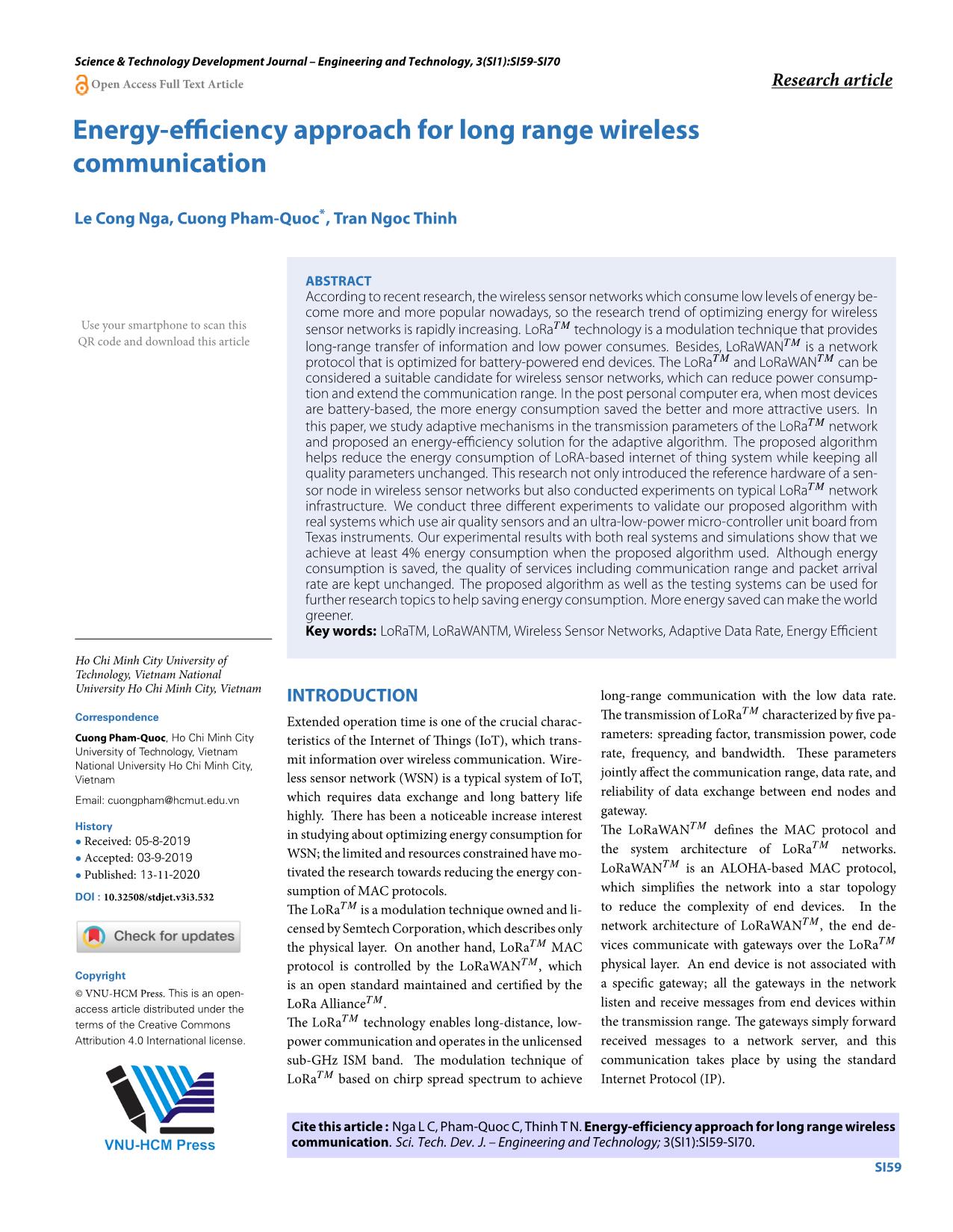
Trang 1
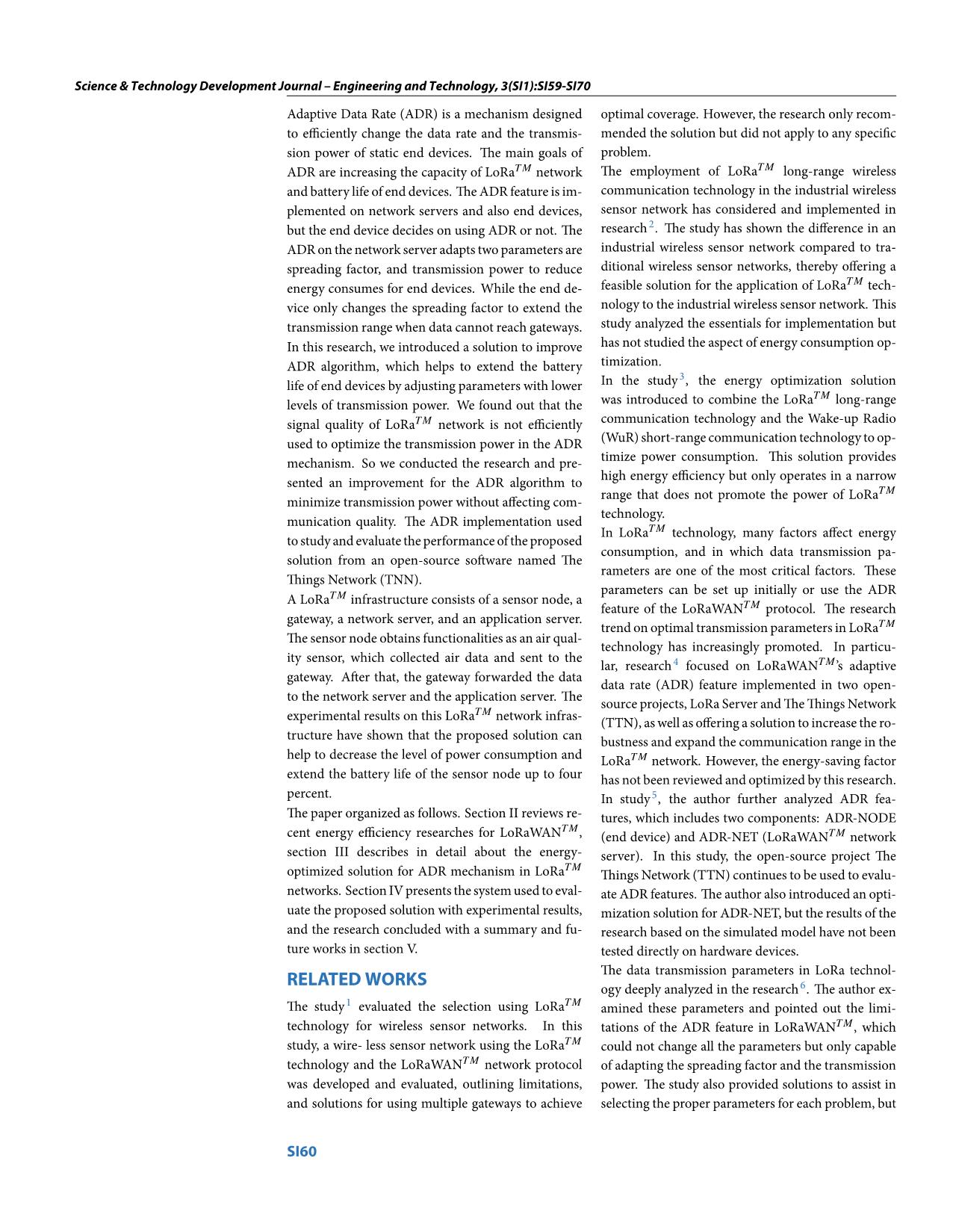
Trang 2
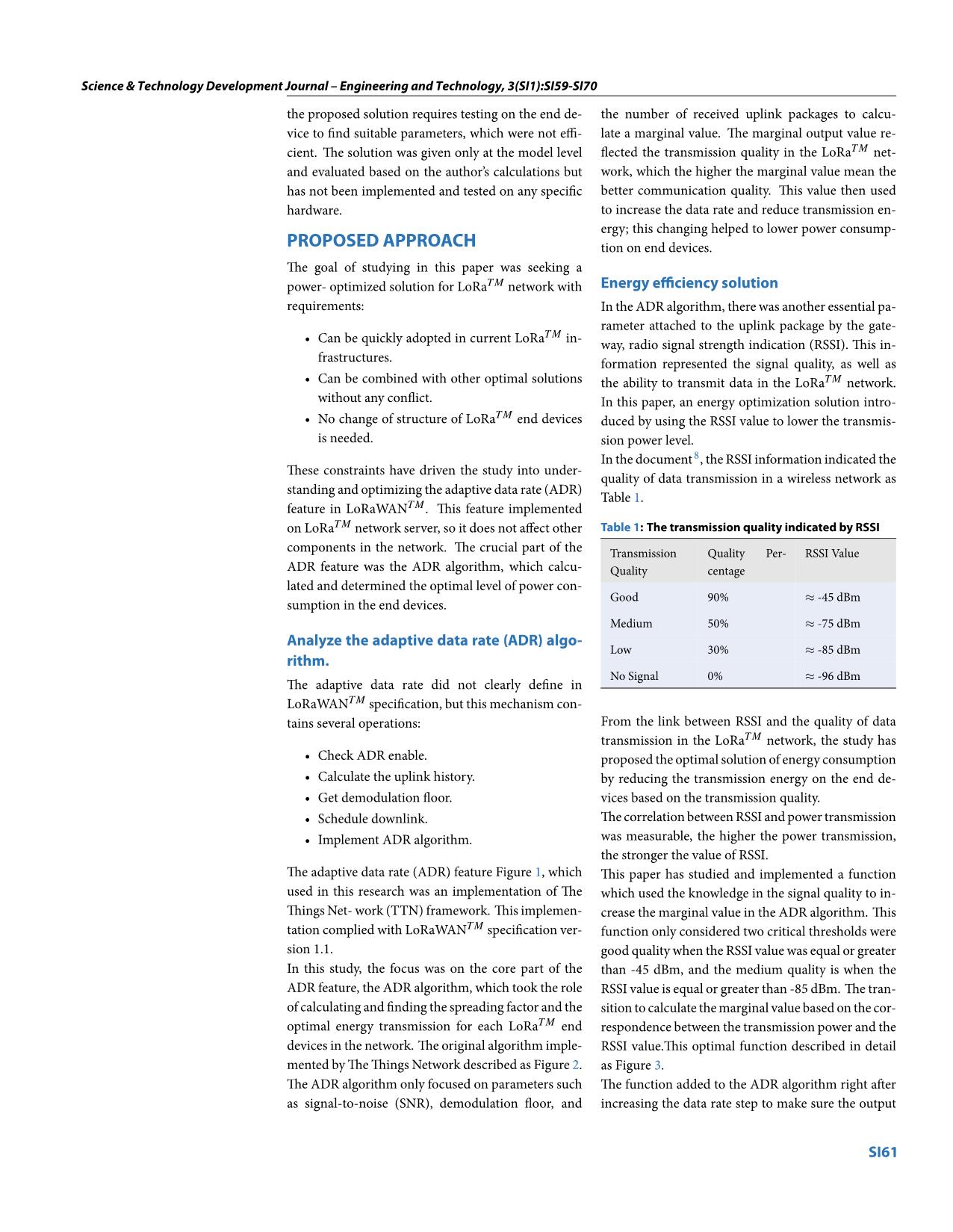
Trang 3
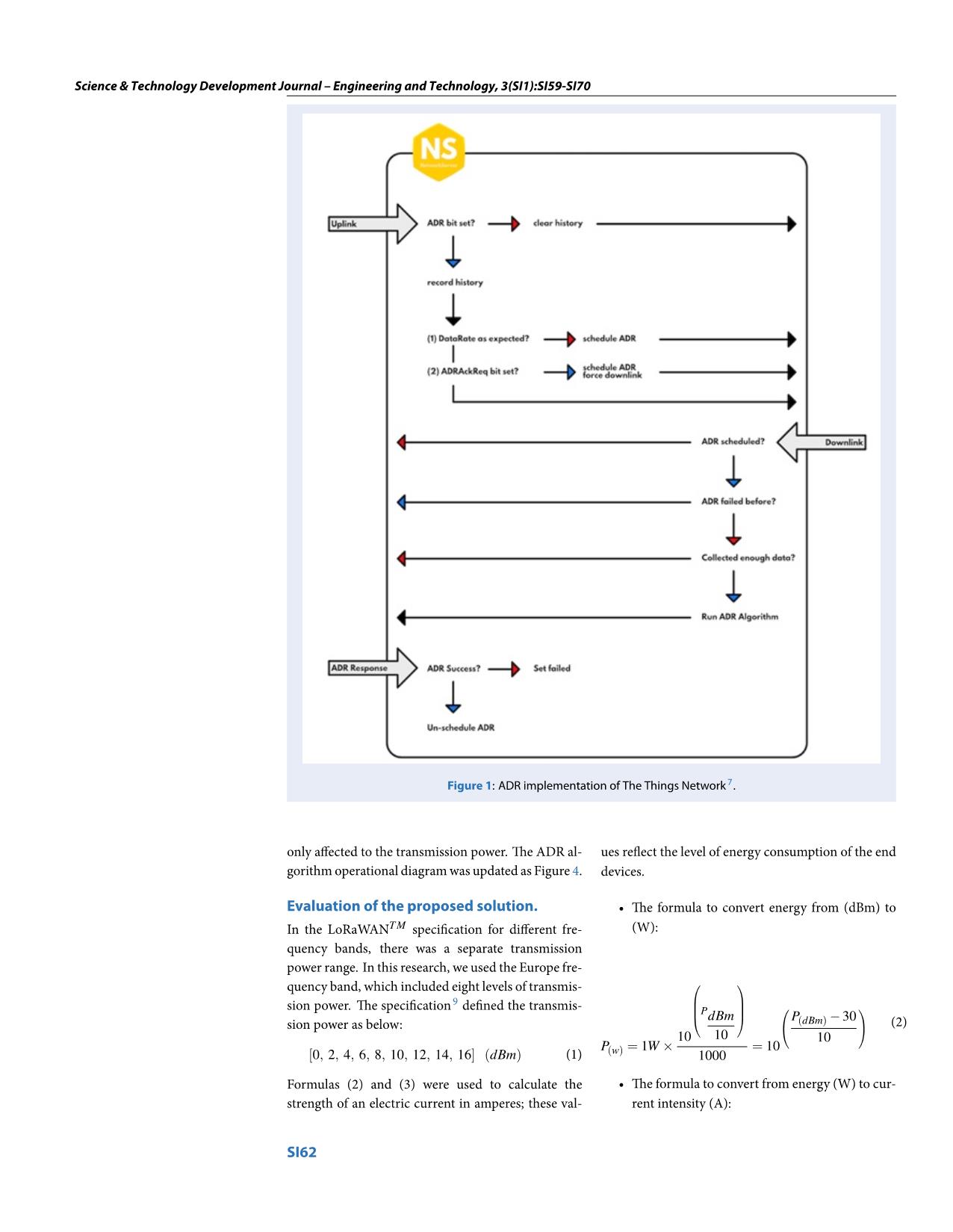
Trang 4
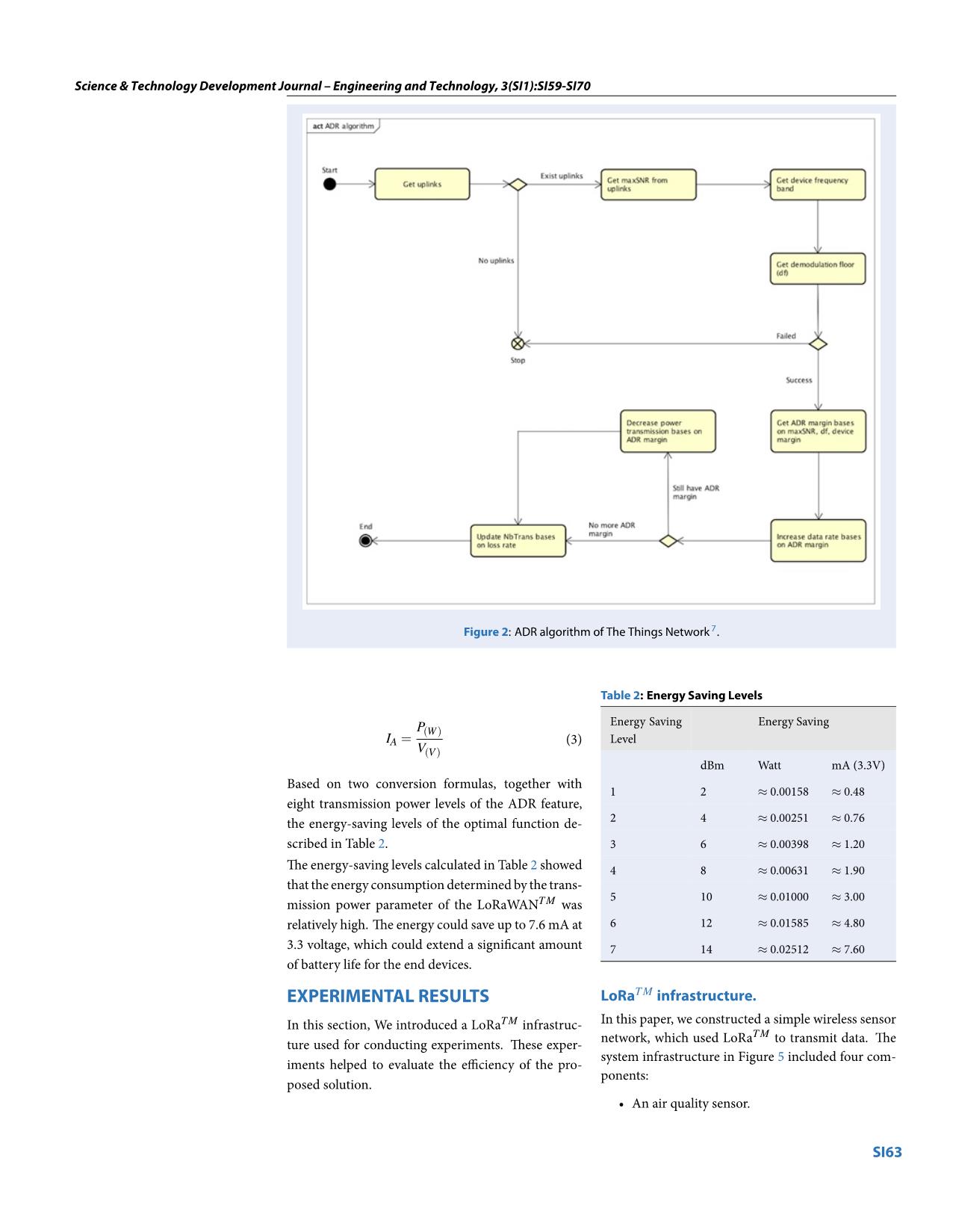
Trang 5
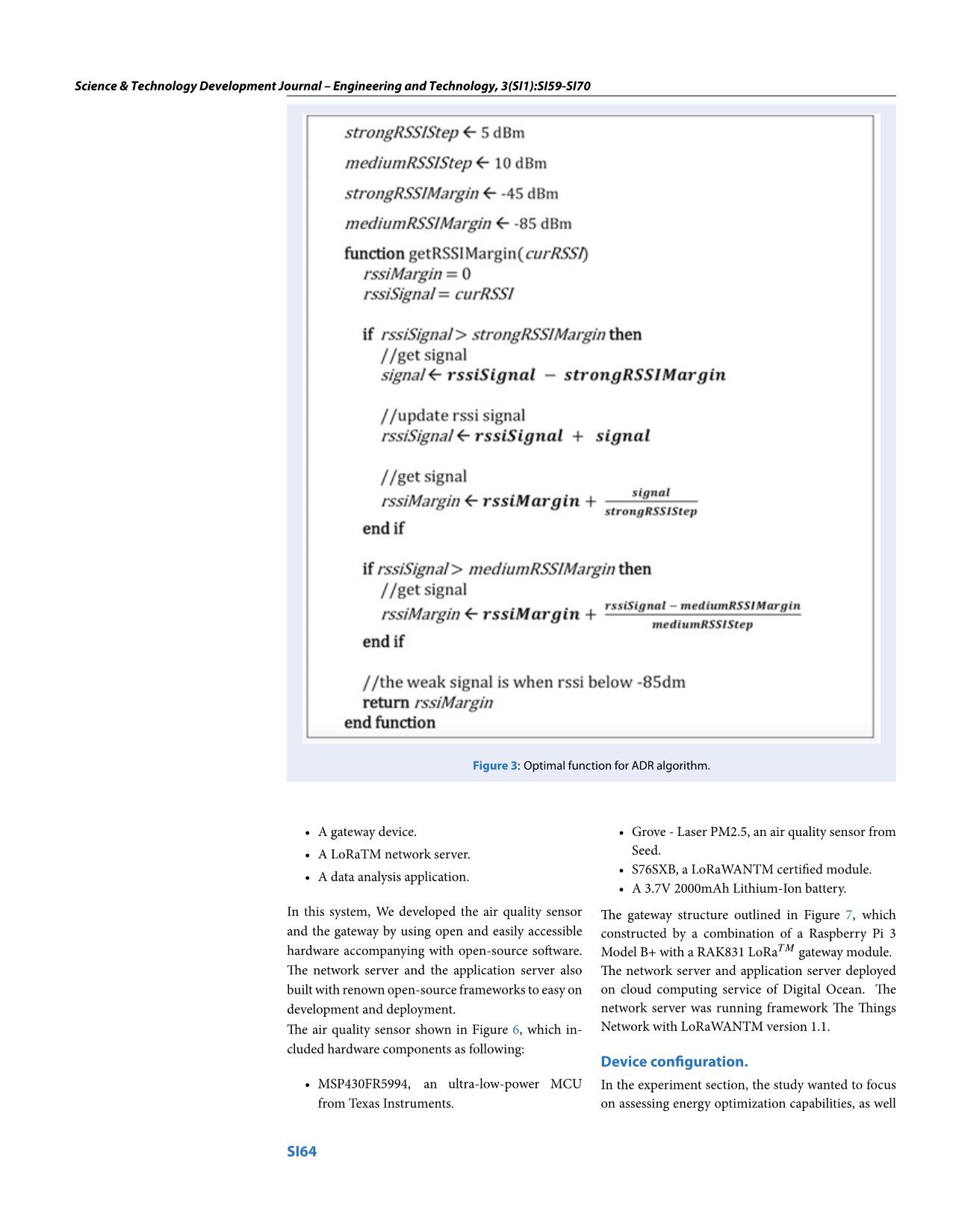
Trang 6
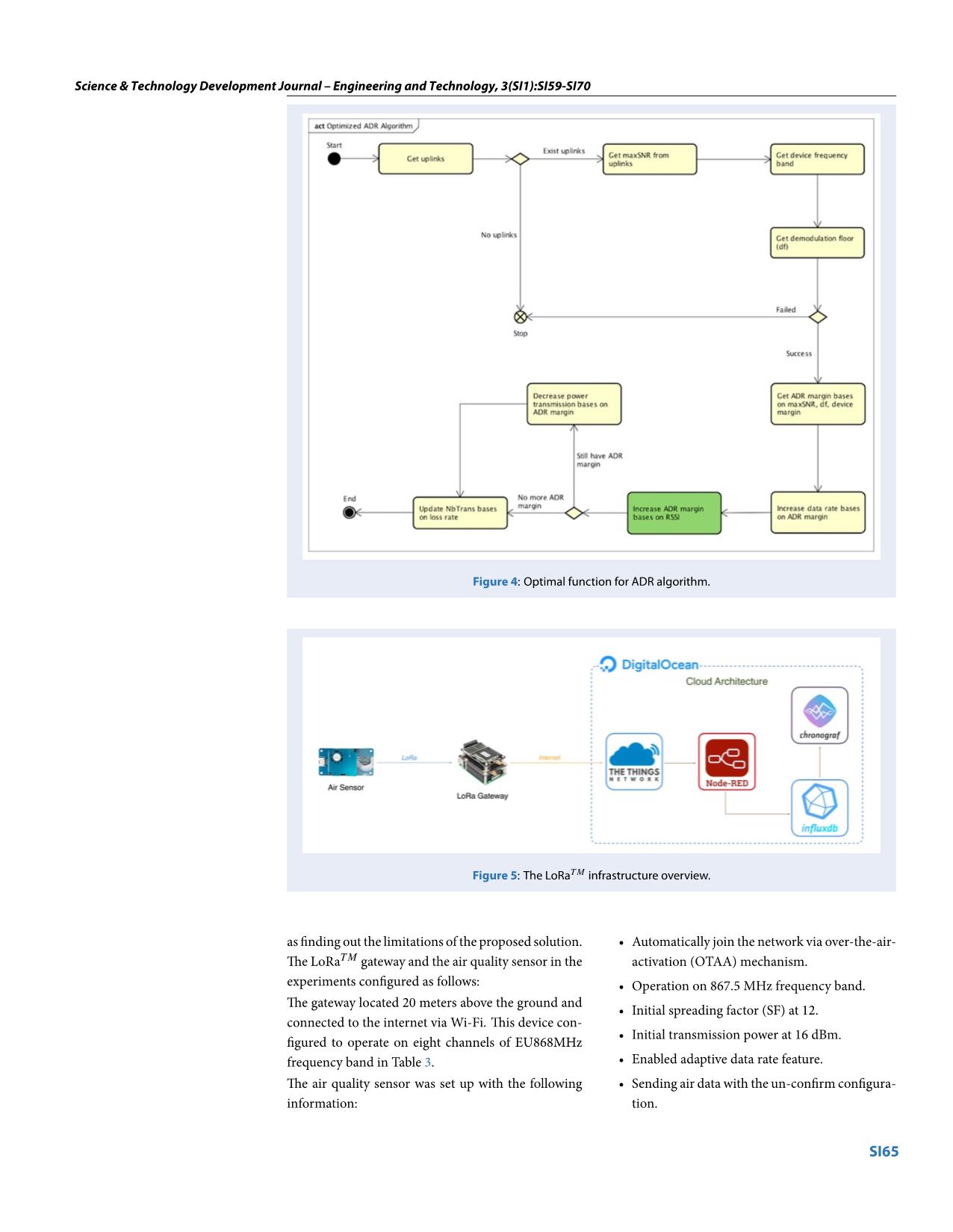
Trang 7
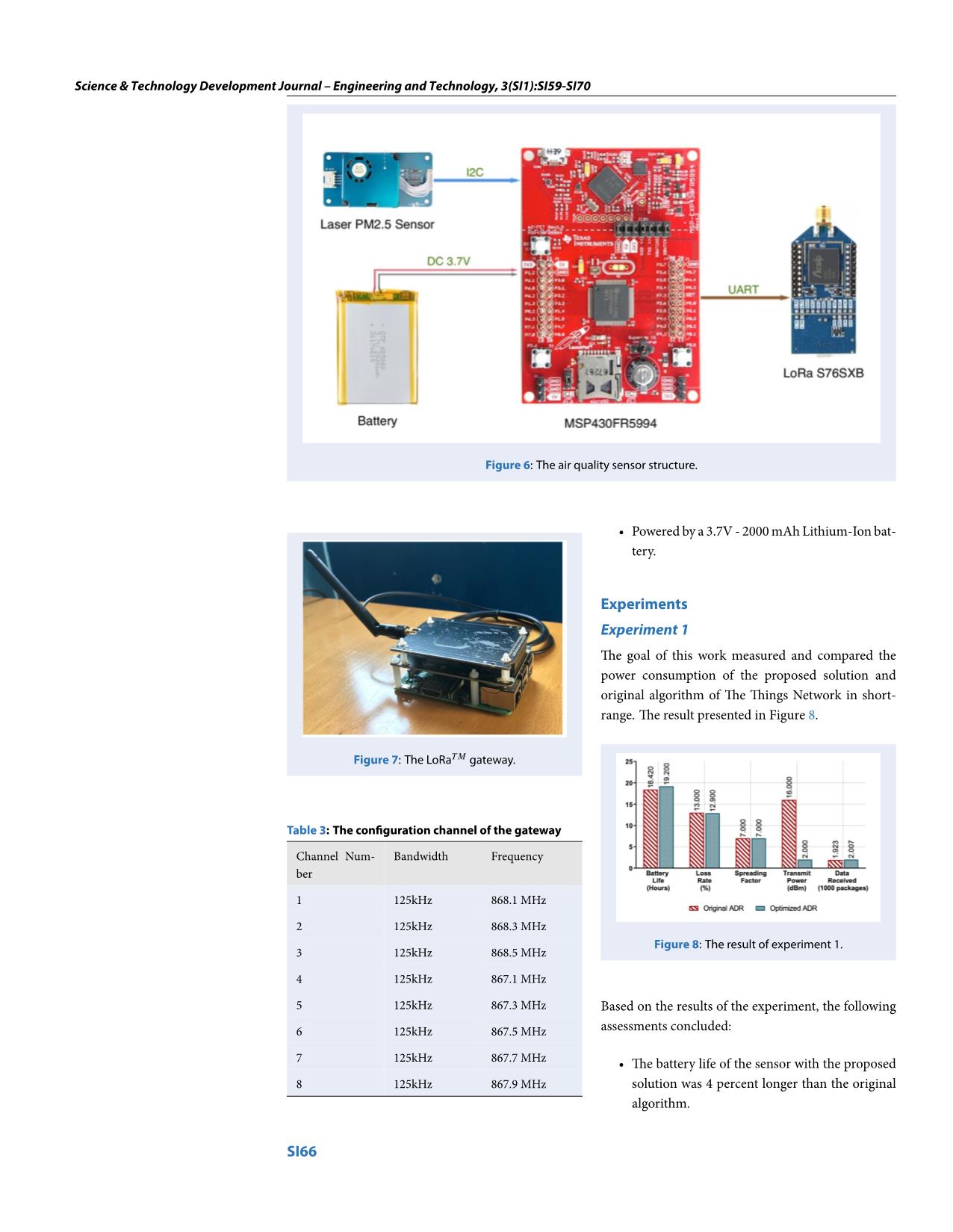
Trang 8
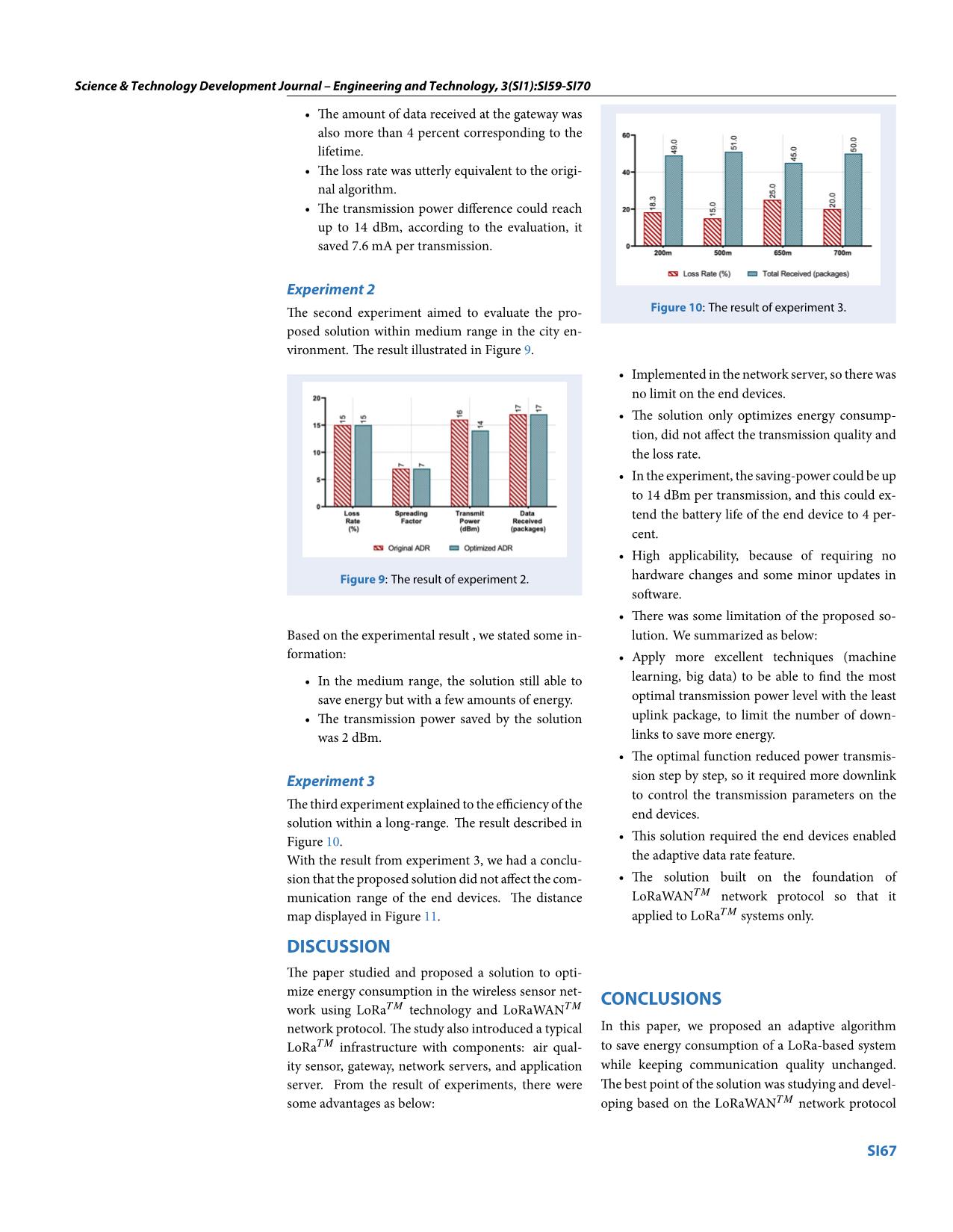
Trang 9
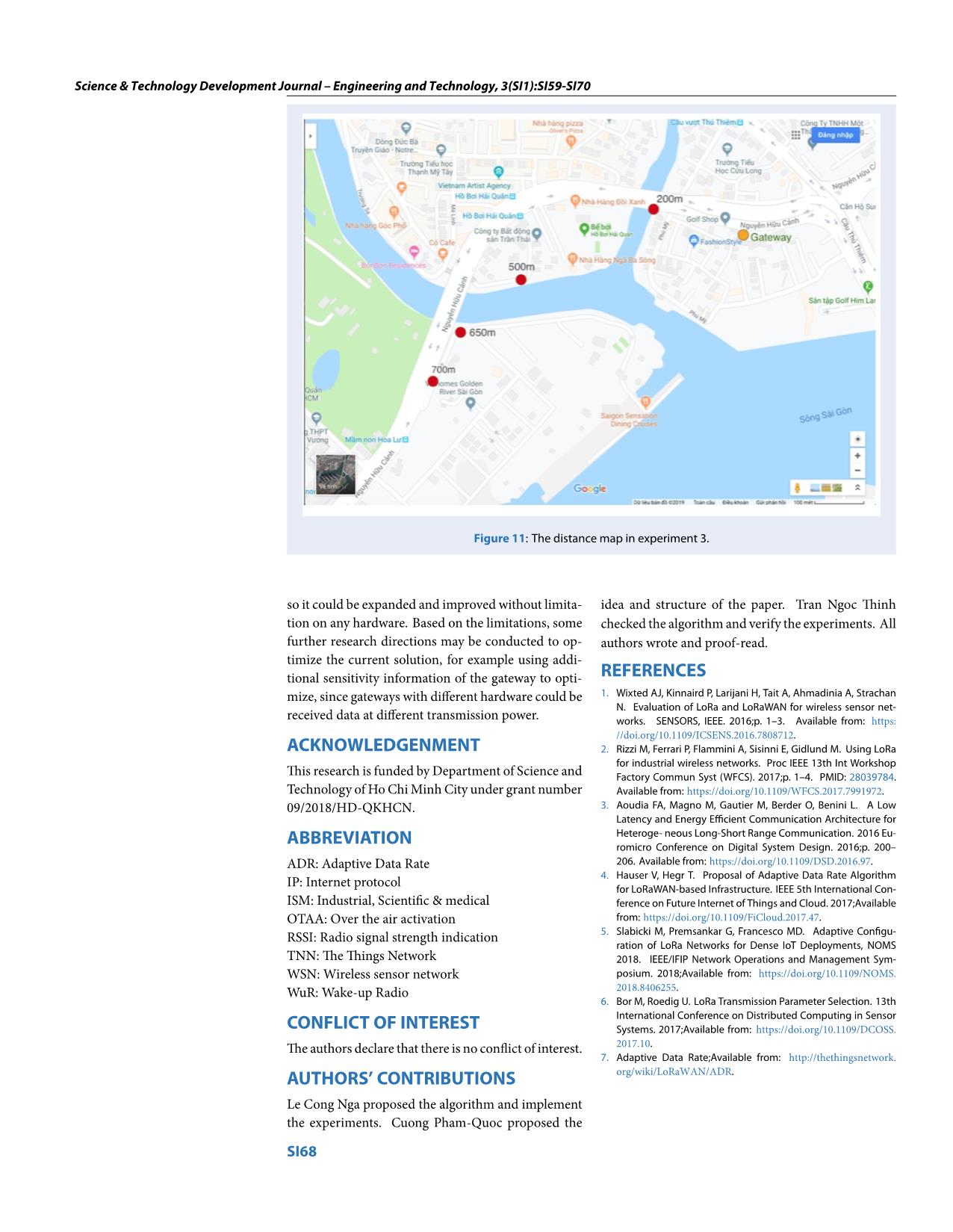
Trang 10
Tải về để xem bản đầy đủ
Tóm tắt nội dung tài liệu: Energy-efficiency approach for long range wireless communication
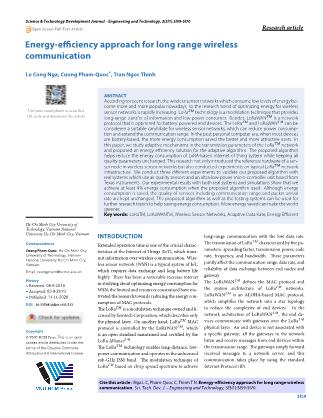
I value.This optimal function described in detail mented by The Things Network described as Figure 2. as Figure 3. The ADR algorithm only focused on parameters such The function added to the ADR algorithm right after as signal-to-noise (SNR), demodulation floor, and increasing the data rate step to make sure the output SI61 Science & Technology Development Journal – Engineering and Technology, 3(SI1):SI59-SI70 Figure 1: ADR implementation of The Things Network 7. only affected to the transmission power. The ADR al- ues reflect the level of energy consumption of the end gorithm operational diagram was updated as Figure 4. devices. Evaluation of the proposed solution. • The formula to convert energy from (dBm) to In the LoRaWANTM specification for different fre- (W): quency bands, there was a separate transmission power range. In this research, we used the Europe fre- quency band, which included eight levels of transmis- sion power. The specification 9 defined the transmis- PdBm P − 30 sion power as below: (dBm) (2) 10 10 10 P = 1W × = 10 [0, 2, 4, 6, 8, 10, 12, 14, 16](dBm) (1) (w) 1000 Formulas (2) and (3) were used to calculate the • The formula to convert from energy (W) to cur- strength of an electric current in amperes; these val- rent intensity (A): SI62 Science & Technology Development Journal – Engineering and Technology, 3(SI1):SI59-SI70 Figure 2: ADR algorithm of The Things Network 7. Table 2: Energy Saving Levels Energy Saving Energy Saving P(W) IA = (3) Level V(V) dBm Watt mA (3.3V) Based on two conversion formulas, together with 1 2 ≈ 0.00158 ≈ 0.48 eight transmission power levels of the ADR feature, ≈ ≈ the energy-saving levels of the optimal function de- 2 4 0.00251 0.76 scribed in Table 2. 3 6 ≈ 0.00398 ≈ 1.20 The energy-saving levels calculated in Table 2 showed 4 8 ≈ 0.00631 ≈ 1.90 that the energy consumption determined by the trans- 5 10 ≈ 0.01000 ≈ 3.00 mission power parameter of the LoRaWANTM was relatively high. The energy could save up to 7.6 mA at 6 12 ≈ 0.01585 ≈ 4.80 3.3 voltage, which could extend a significant amount 7 14 ≈ 0.02512 ≈ 7.60 of battery life for the end devices. EXPERIMENTAL RESULTS LoRaTM infrastructure. In this section, We introduced a LoRaTM infrastruc- In this paper, we constructed a simple wireless sensor network, which used LoRaTM to transmit data. The ture used for conducting experiments. These exper- system infrastructure in Figure 5 included four com- iments helped to evaluate the efficiency of the pro- ponents: posed solution. • An air quality sensor. SI63 Science & Technology Development Journal – Engineering and Technology, 3(SI1):SI59-SI70 Figure 3: Optimal function for ADR algorithm. • A gateway device. • Grove - Laser PM2.5, an air quality sensor from • A LoRaTM network server. Seed. • S76SXB, a LoRaWANTM certified module. • A data analysis application. • A 3.7V 2000mAh Lithium-Ion battery. In this system, We developed the air quality sensor The gateway structure outlined in Figure 7, which and the gateway by using open and easily accessible constructed by a combination of a Raspberry Pi 3 hardware accompanying with open-source software. Model B+ with a RAK831 LoRaTM gateway module. The network server and the application server also The network server and application server deployed built with renown open-source frameworks to easy on on cloud computing service of Digital Ocean. The development and deployment. network server was running framework The Things The air quality sensor shown in Figure 6, which in- Network with LoRaWANTM version 1.1. cluded hardware components as following: Device configuration. • MSP430FR5994, an ultra-low-power MCU In the experiment section, the study wanted to focus from Texas Instruments. on assessing energy optimization capabilities, as well SI64 Science & Technology Development Journal – Engineering and Technology, 3(SI1):SI59-SI70 Figure 4: Optimal function for ADR algorithm. Figure 5: The LoRaTM infrastructure overview. as finding out the limitations of the proposed solution. • Automatically join the network via over-the-air- The LoRaTM gateway and the air quality sensor in the activation (OTAA) mechanism. experiments configured as follows: • Operation on 867.5 MHz frequency band. The gateway located 20 meters above the ground and • Initial spreading factor (SF) at 12. connected to the internet via Wi-Fi. This device con- • Initial transmission power at 16 dBm. figured to operate on eight channels of EU868MHz frequency band in Table 3. • Enabled adaptive data rate feature. The air quality sensor was set up with the following • Sending air data with the un-confirm configura- information: tion. SI65 Science & Technology Development Journal – Engineering and Technology, 3(SI1):SI59-SI70 Figure 6: The air quality sensor structure. • Powered by a 3.7V - 2000 mAh Lithium-Ion bat- tery. Experiments Experiment 1 The goal of this work measured and compared the power consumption of the proposed solution and original algorithm of The Things Network in short- range. The result presented in Figure 8. Figure 7: The LoRaTM gateway. Table 3: The configuration channel of the gateway Channel Num- Bandwidth Frequency ber 1 125kHz 868.1 MHz 2 125kHz 868.3 MHz Figure 8: The result of experiment 1. 3 125kHz 868.5 MHz 4 125kHz 867.1 MHz 5 125kHz 867.3 MHz Based on the results of the experiment, the following 6 125kHz 867.5 MHz assessments concluded: 7 125kHz 867.7 MHz • The battery life of the sensor with the proposed 8 125kHz 867.9 MHz solution was 4 percent longer than the original algorithm. SI66 Science & Technology Development Journal – Engineering and Technology, 3(SI1):SI59-SI70 • Themount a of data received at the gateway was also more than 4 percent corresponding to the lifetime. • The loss rate was utterly equivalent to the origi- nal algorithm. • The transmission power difference could reach up to 14 dBm, according to the evaluation, it saved 7.6 mA per transmission. Experiment 2 The second experiment aimed to evaluate the pro- Figure 10: The result of experiment 3. posed solution within medium range in the city en- vironment. The result illustrated in Figure 9. • Implemented in the network server, so there was no limit on the end devices. • The solution only optimizes energy consump- tion, did not affect the transmission quality and the loss rate. • In the experiment, the saving-power could be up to 14 dBm per transmission, and this could ex- tend the battery life of the end device to 4 per- cent. • High applicability, because of requiring no Figure 9: The result of experiment 2. hardware changes and some minor updates in software. • There was some limitation of the proposed so- Based on the experimental result , we stated some in- lution. We summarized as below: formation: • Apply more excellent techniques (machine • In the medium range, the solution still able to learning, big data) to be able to find the most save energy but with a few amounts of energy. optimal transmission power level with the least • The transmission power saved by the solution uplink package, to limit the number of down- was 2 dBm. links to save more energy. • The optimal function reduced power transmis- Experiment 3 sion step by step, so it required more downlink to control the transmission parameters on the The third experiment explained to the efficiency ofthe end devices. solution within a long-range. The result described in Figure 10. • This solution required the end devices enabled With the result from experiment 3, we had a conclu- the adaptive data rate feature. sion that the proposed solution did not affect the com- • The solution built on the foundation of munication range of the end devices. The distance LoRaWANTM network protocol so that it map displayed in Figure 11. applied to LoRaTM systems only. DISCUSSION The paper studied and proposed a solution to opti- mize energy consumption in the wireless sensor net- CONCLUSIONS work using LoRaTM technology and LoRaWANTM network protocol. The study also introduced a typical In this paper, we proposed an adaptive algorithm LoRaTM infrastructure with components: air qual- to save energy consumption of a LoRa-based system ity sensor, gateway, network servers, and application while keeping communication quality unchanged. server. From the result of experiments, there were The best point of the solution was studying and devel- some advantages as below: oping based on the LoRaWANTM network protocol SI67 Science & Technology Development Journal – Engineering and Technology, 3(SI1):SI59-SI70 Figure 11: The distance map in experiment 3. so it could be expanded and improved without limita- idea and structure of the paper. Tran Ngoc Thinh tion on any hardware. Based on the limitations, some checked the algorithm and verify the experiments. All further research directions may be conducted to op- authors wrote and proof-read. timize the current solution, for example using addi- tional sensitivity information of the gateway to opti- REFERENCES mize, since gateways with different hardware could be 1. Wixted AJ, Kinnaird P, Larijani H, Tait A, Ahmadinia A, Strachan N. Evaluation of LoRa and LoRaWAN for wireless sensor net- received data at different transmission power. works. SENSORS, IEEE. 2016;p. 1–3. Available from: https: //doi.org/10.1109/ICSENS.2016.7808712. ACKNOWLEDGENMENT 2. Rizzi M, Ferrari P, Flammini A, Sisinni E, Gidlund M. Using LoRa for industrial wireless networks. Proc IEEE 13th Int Workshop This research is funded by Department of Science and Factory Commun Syst (WFCS). 2017;p. 1–4. PMID: 28039784. Technology of Ho Chi Minh City under grant number Available from: https://doi.org/10.1109/WFCS.2017.7991972. 09/2018/HD-QKHCN. 3. Aoudia FA, Magno M, Gautier M, Berder O, Benini L. A Low Latency and Energy Efficient Communication Architecture for Heteroge- neous Long-Short Range Communication. 2016 Eu- ABBREVIATION romicro Conference on Digital System Design. 2016;p. 200– ADR: Adaptive Data Rate 206. Available from: https://doi.org/10.1109/DSD.2016.97. 4. Hauser V, Hegr T. Proposal of Adaptive Data Rate Algorithm IP: Internet protocol for LoRaWAN-based Infrastructure. IEEE 5th International Con- ISM: Industrial, Scientific & medical ference on Future Internet of Things and Cloud. 2017;Available OTAA: Over the air activation from: https://doi.org/10.1109/FiCloud.2017.47. RSSI: Radio signal strength indication 5. Slabicki M, Premsankar G, Francesco MD. Adaptive Configu- ration of LoRa Networks for Dense IoT Deployments, NOMS TNN: The Things Network 2018. IEEE/IFIP Network Operations and Management Sym- WSN: Wireless sensor network posium. 2018;Available from: https://doi.org/10.1109/NOMS. WuR: Wake-up Radio 2018.8406255. 6. Bor M, Roedig U. LoRa Transmission Parameter Selection. 13th International Conference on Distributed Computing in Sensor CONFLICT OF INTEREST Systems. 2017;Available from: https://doi.org/10.1109/DCOSS. The authors declare that there is no conflict of interest. 2017.10. 7. Adaptive Data Rate;Available from: AUTHORS’ CONTRIBUTIONS org/wiki/LoRaWAN/ADR. Le Cong Nga proposed the algorithm and implement the experiments. Cuong Pham-Quoc proposed the SI68 Science & Technology Development Journal – Engineering and Technology, 3(SI1):SI59-SI70 8. How does RSSI (dBm) relate to signal quality (percent);Available 9. LoRaWANTM Specification version 1.1. 2017;Available from: https://www.speedguide.net/faq/how-does-rssi-dbm- from: https://lora-alliance.org/resource-hub/lorawantm- relate-to-signal-quality-percent-439. specification-v11. SI69 Tạp chí Phát triển Khoa học và Công nghệ – Kĩ thuật và Công nghệ, 3(SI1):SI59-SI70 Open Access Full Text Article Bài Nghiên cứu Giải pháp tiết kiệm năng lượng cho công nghệ giao tiếp không dây tầm xa Lê Công Ngà, Phạm Quốc Cường*, Trần Ngọc Thịnh TÓM TẮT Theo các nghiên cứu gần đây, mạng cảm biến không dây (Wireless Sensor Network) tiêu thụ năng lượng thấp sẽ ngày càng trở nên phổ biến, thúc đẩy xu hướng nghiên cứu về tối ưu hoá năng lượng Use your smartphone to scan this cho mạng cảm biến không dây tăng nhanh. Công nghệ LoRaTM là một công nghệ điều chế sóng QR code and download this article mang đến khả năng truyền tải dữ liệu ở khoảng cách xa với mức yêu cầu năng lượng thấp, thêm vào đó LoRaWANTM là một giao thức mạng dựa trên công nghệ LoRaTM được thiết kế nhằm ưu hoá cho các thiết bị hoạt động dựa trên nguồn năng lượng là pin. Hai công nghệ này được đánh giá là giải pháp phù hợp cho mạng cảm biến không dây, giúp giảm mức năng lượng tiêu thụ và mở rộng tầm hoạt động. Trong thời đại hậu máy tính cá nhân, khi các thiết bị chủ yếu sử dụng pin thì việc tiết kiệm năng lượng là một trong những yếu tố rất quan trọng và hấp dẫn người sử dụng. Trong bài báo này, chúng tôi nghiên cứu về kỹ thuật thích ứng trong thiết lập các thông số truyền tải dữ liệu của mạng LoRaTM và đề xuất một giải pháp tiết kiệm năng lượng cho giải thuật thích ứng. Giải thuật của chúng tôi giúp tiết kiệm năng lượng nhưng vẫn giữ nguyên chất lượng truyền dẫn theo giao thức LoRa. Nghiên cứu này giới thiệu một phần cứng mẫu của một nút cảm biến trong mạng cảm biến không dây, cũng như hiện thực một hệ thống mạng LoRaTM điển hình. Chúng tôi tiến hành ba thí nghiệm khác nhau với các cảm biến chất lượng không khí và các bo mạch MCU của hãng Texas instrument. Các thí nghiệm của chúng tôi được tiến hành với hệ thống thực và mô phỏng đều cho kết quả tốt với tối thiểu 4% năng lượng được tiết kiệm. Mặc dù tiết kiệm năng lượng nhưng chất lượng truyền dẫn về khoản cách và tỉ lệ gói tin đến đều được giữ nguyên. Các hệ thống thực nghiệm và giải thuật có thể được dùng cho các nghiên cứu khác cùng chủ đề. Ngày nay, càng tiết kiệm năng lượng sẽ càng làm cho thế giới xanh hơn. Từ khoá: LoRaTM, LoRaWANTM, Mạng Cảm Biến Không Dây, Tốc Độ Dữ Liệu Thích Ứng, Tiết Kiệm Năng Lượng Trường Đại Học Bách khoa – Đại học Quốc Gia Thành Phố Hồ Chí Minh Liên hệ Phạm Quốc Cường, Trường Đại Học Bách khoa – Đại học Quốc Gia Thành Phố Hồ Chí Minh Email: cuongpham@hcmut.edu.vn Lịch sử • Ngày nhận: 05-8-2019 • Ngày chấp nhận: 03-9-2019 • Ngày đăng: 13-11-2020 DOI :10.32508/stdjet.v3i3.532 Bản quyền © ĐHQG Tp.HCM. Đây là bài báo công bố mở được phát hành theo các điều khoản của the Creative Commons Attribution 4.0 International license. Trích dẫn bài báo này: Ngà L C, Cường P Q, Thịnh T N. Giải pháp t iết kiệm năng l ượng cho công nghệ giao t iếp không dây t ầm xa. Sci. Tech. Dev. J. - Eng. Tech.; 3(SI1):SI59-SI70. SI70
File đính kèm:
 energy_efficiency_approach_for_long_range_wireless_communica.pdf
energy_efficiency_approach_for_long_range_wireless_communica.pdf

